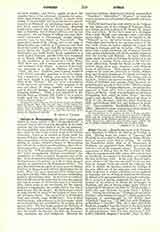

Otfried of Weiesenburg, the oldest German poet known by name, author of the “Evangelienbuch”, a rhymed version of the Gospels, flourished in the ninth century, but the exact dates of his life are unknown. He was probably born at or near Weissenburg in Alsace, where he also seems to have received his earliest education. Later on he studied at Fulda under the famous Rabanus Maurus, who was abbot there after 822 and presided over the monastic school. After completing his studies, Otfried returned to Weissenburg and entered the well-known Benedictine abbey there, becoming prefect of the abbey-school. He was notary there in 851. At Weissenburg he began his great poem, the “Liber evangeliorum theotisce conscriptus”, the completion of which occupied the greater part of his life. It was dedicated to King Louis the German and to Bishop Salomo of Constance, to both of whom rhymed epistles are addressed in the Franconian dialect. The poet also addressed an epistle in Latin prose to Bishop Liutbert of Mainz to gain official approbation for his work. Hence the poem must have been finished some time between 863, when Liutbert became archbishop, and 871, when Salomo died. In the letter to Liutbert, Otfried tells us that he undertook to write the poem at the request of some of the brethren and of a venerable lady, whose name is not mentioned, for the express purpose of supplanting the worldly poetry that found such favor with the people. He furthermore wished to make known the story of the Gospels to those who did not know Latin. The poem itself is in strophic form and contains some 15,000 lines. It is divided into five books, with reference to the five senses, which are to be purified and sanctified by the reading of the sacred story. The first book narrates the Nativity of Christ; the second and third, His Teachings and Miracles; the fourth, the Passion; the fifth, the Resurrection, Ascension, and Last Judgment. Between the narrative portions chapters are inserted superscribed “Moraliter”, “Spiritaliter”, “Mystice”, in which the events narrated are interpreted allegorically and symbolically.
While Otfried bases his work chiefly on the Vulgate, he also makes use of the writings of Rabanus, Bede, and Alcuin, as well as those of St. Jerome, St. Augustine, and others. In fact he is more of a theologian than a poet, though some passages show undeniable poetic talent. Still, the poem is far inferior to the “Heliand” (q.v.), and never became really popular. Particularly noteworthy is the opening chapter of the first book, where the author explains his reasons for writing in German, and not in Latin. This passage glows with a noble patriotism; the Franks are praised with sincere enthusiasm and are favorably compared with the Greeks and Romans. In form, Otfried’s poem marks an epoch in German literature: it is the first poem to employ rhyme instead of the old Germanic alliteration, though the rhyme is still very imperfect, being often mere assonance, with frequent traces of alliteration. Three almost complete manuscripts of the work are preserved, at Vienna, Heidelberg, and Munich; fragments of a fourth are found at Berlin, Wolfenbüttel, and Bonn. The Vienna codex is the best. Otfried was noticed as early as 1495 by the Abbot of Tritheim, and passages from his poem appeared in print as early as 1531, in the “Libri tres rerum Germanicarum” of Beatus Rhenanus. An edition then appeared at Basle, 1571, with a preface by Mathias Flacius, of Illyria. Graff, who published an edition at Königsberg, 1831, called the poem “Krist”, but that name is now obsolete. Modern editions are those of Kelle (3 vols., Ratisbon, 1856-81), Piper (Paderborn, 1878, and Freiburg, 1882-84), and Erdmann in Zacher’s “Germanistische Handbibliothek”, V (Halle, 1882). Modern German versions have been made by Rapp (Stuttgart, 1858) and Kelle (1870).
ARTHUR F. J. REMY

